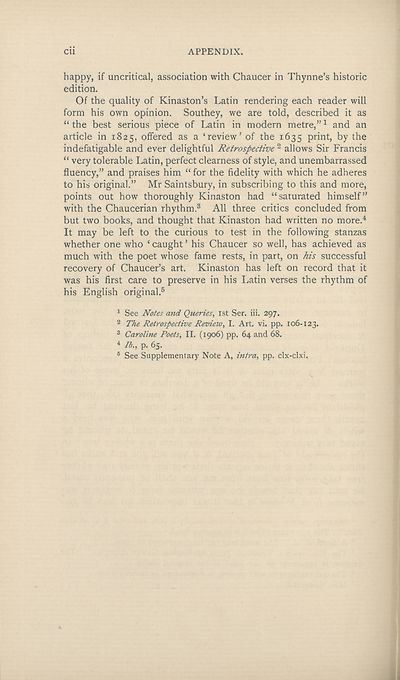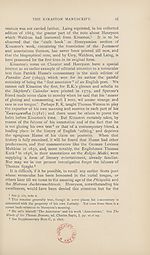Download files
Complete book:
Individual page:
Thumbnail gallery: Grid view | List view

cn
APPENDIX.
happy, if uncritical, association with Chaucer in Thynne’s historic
edition.
Of the quality of Kinaston’s Latin rendering each reader will
form his own opinion. Southey, we are told, described it as
“ the best serious piece of Latin in modern metre,”1 and an
article in 1825, offered as a ‘review’ of the 1635 print, by the
indefatigable and ever delightful Retrospective 2 allows Sir Francis
“ very tolerable Latin, perfect clearness of style, and unembarrassed
fluency,” and praises him “ for the fidelity with which he adheres
to his original.” Mr Saintsbury, in subscribing to this and more,
points out how thoroughly Kinaston had “saturated himself”
with the Chaucerian rhythm.3 All three critics concluded from
but two books, and thought that Kinaston had written no more.4
It may be left to the curious to test in the following stanzas
whether one who ‘ caught ’ his Chaucer so well, has achieved as
much with the poet whose fame rests, in part, on his successful
recovery of Chaucer’s art. Kinaston has left on record that it
was his first care to preserve in his Latin verses the rhythm of
his English original.5
1 See Notes and Queries, 1st Ser. iii. 297.
2 The Retrospective Review, I. Art. vi. pp. 106-123.
3 Caroline Poets, II. (1906) pp. 64 and 68.
4 lb., p. 65.
6 See Supplementary Note A, mtra, pp. clx-clxi.
APPENDIX.
happy, if uncritical, association with Chaucer in Thynne’s historic
edition.
Of the quality of Kinaston’s Latin rendering each reader will
form his own opinion. Southey, we are told, described it as
“ the best serious piece of Latin in modern metre,”1 and an
article in 1825, offered as a ‘review’ of the 1635 print, by the
indefatigable and ever delightful Retrospective 2 allows Sir Francis
“ very tolerable Latin, perfect clearness of style, and unembarrassed
fluency,” and praises him “ for the fidelity with which he adheres
to his original.” Mr Saintsbury, in subscribing to this and more,
points out how thoroughly Kinaston had “saturated himself”
with the Chaucerian rhythm.3 All three critics concluded from
but two books, and thought that Kinaston had written no more.4
It may be left to the curious to test in the following stanzas
whether one who ‘ caught ’ his Chaucer so well, has achieved as
much with the poet whose fame rests, in part, on his successful
recovery of Chaucer’s art. Kinaston has left on record that it
was his first care to preserve in his Latin verses the rhythm of
his English original.5
1 See Notes and Queries, 1st Ser. iii. 297.
2 The Retrospective Review, I. Art. vi. pp. 106-123.
3 Caroline Poets, II. (1906) pp. 64 and 68.
4 lb., p. 65.
6 See Supplementary Note A, mtra, pp. clx-clxi.
Set display mode to: Large image | Zoom image | Transcription
Images and transcriptions on this page, including medium image downloads, may be used under the Creative Commons Attribution 4.0 International Licence unless otherwise stated. ![]()
| Publications by Scottish clubs > Scottish Text Society publications > Old series > Poems of Robert Henryson > Volume 1, 1914 > (112) |
|---|
| Permanent URL | https://digital.nls.uk/107411519 |
|---|
| Shelfmark | SCS.STES1.64 |
|---|---|
| Attribution and copyright: |
|
| Description | Edited by G. Gregory Smith. |
|---|---|
| Shelfmark | SCS.STES1.64 and SCS.STES1.55 |
| Additional NLS resources: | |
| Description | A collection of over 100 Scottish texts dating from around 1400 to 1700. Most titles are in Scots, and include editions of poetry, drama, and prose by major Scottish writers such as John Barbour, William Dunbar, Gavin Douglas, and George Buchanan. Edited by a key scholarly publisher of Scotland's literary history, and published from the late 19th century onwards by the Scottish Text Society. Available here are STS series 1-3. |
|---|

